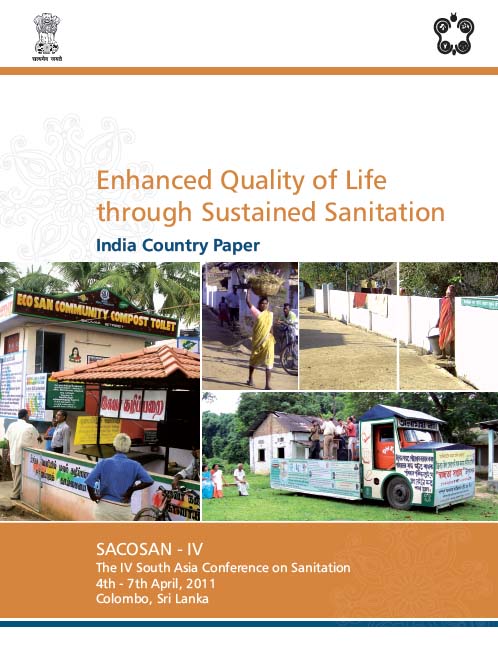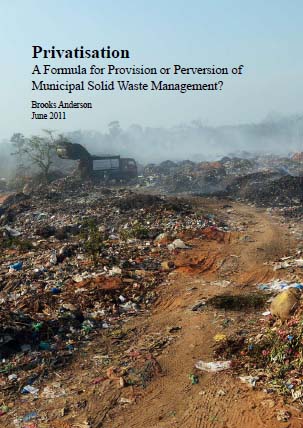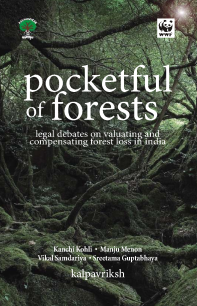/topics/governance
Governance
Enhanced quality of life through sustained sanitation - India country paper for South Asia Conference on Sanitation
Posted on 24 Jun, 2011 10:09 PM This India Country Paper on Enhanced Quality of Life through Sustained Sanitation was prepared for South Asia Conference on Sanitation (SACOSAN) IV held at Colombo, Sri Lanka in April, 2011.
This India Country Paper on Enhanced Quality of Life through Sustained Sanitation was prepared for South Asia Conference on Sanitation (SACOSAN) IV held at Colombo, Sri Lanka in April, 2011.
In rural sanitation, India’s flagship rural sanitation programme, the Total Sanitation Campaign (TSC), continues to be implemented with renewed vigour, and improvements in multiple facets of the programme. The TSC programme was given a further boost with the introduction of the Nirmal Gram Puraskar (NGP), an innovative incentive scheme for Gram Panchayats, Blocks and Districts. The rural sanitation sector has continued to receive increasing budgetary support.
Is privatisation a formula for provision or perversion of municipal solid waste management?
Posted on 24 Jun, 2011 09:17 PM
In 2000, in response to a Supreme Court order, the Government of India formulated and enacted the Municipal Solid Wastes (Management and Handling) Rules (hereafter referred to as the Rules) to mitigate a burgeoning solid waste crisis. Pollution from haphazard municipal solid waste disposal was gravely jeopardizing public health, thereby undermining the nation’s development gains.
The Rules’ prime objective was to protect public health and the environment by minimizing disposal of waste in landfills, thereby aligning the government’s municipal waste management policy with its commitments to international treaties to reduce greenhouse gas emissions, control the production of persistent organic pollutants, conserve finite resources, and achieve broad development targets.
Scaling up rural sanitation: Findings from the impact evaluation baseline survey in Madhya Pradesh
Posted on 24 Jun, 2011 03:43 PMThis report is a part of a series of papers that analysed the baseline data from all countries where the program was implemented.
Gravity based spring water supply systems in Vishakhapatnam: A sustainable solution to an age-old problem
Posted on 23 Jun, 2011 05:42 PM With an annual rainfall of more than 1200 mm, this region has truly pristine and under-developed ground water resources. The water related issues are more complex in the hilly areas. Some of the most concerning issues that affect the current water scenario in the Eastern Ghats are pollution of water sources (springs & streams) leading to poor health, illiteracy and ignorance resulting in improper hygiene and sanitation practices. The burden on women and children is also high since they have to walk a long distance to the springs/streams for fetching water.
Alternate management approaches for village water supply systems - Case studies from Maharashtra - A field note by WSP
Posted on 23 Jun, 2011 05:25 PMIt documents the approaches in a context where the state government agencies responsible for construction and management of rural water supply systems have been found to be facing limitations in O&M arrangements.
The traditional approach to provision of rural water supply in India has been supply driven, with emphasis on norms and targets and on construction and creation of assets, but with very little concern for sustainable arrangements for better management and maintenance of the facilities built. The viewpoint that users are ‘beneficiaries’ rather than empowered stakeholders among the service providers has led to alienation of the users.
Five years of special economic zones in India' - lecture by Dr. Partho Sarothi Ray, National Institute of Advanced Studies, June 27, 2011, Bangalore
Posted on 23 Jun, 2011 05:11 PM Organizer: National Institute of Advanced Studies
Organizer: National Institute of Advanced Studies
Venue: Lecture Hall, NIAS, IISc Campus, Bangalore
Description:
Five years have passed since the first United Progressive Alliance (UPA) government passed the Special Economic Zones (SEZ) Act in 2005. Altogether there are around 1200 SEZs in different phases of development today. Analyzing the development and distribution of SEZs in different parts of India in the last five years gives us some ideas about the political geography of special economic zones in India.
This talk will draw on this analysis and the personal experience of the speaker in struggles against various SEZs in India including the proposed POSCO SEZ in Orissa which has received a very strong farmers’ resistance.
Amity School invites applications for MBA - Rural management
Posted on 23 Jun, 2011 11:40 AMAmity School of Rural Management, one of the leading institutions of Amity University, Uttar Pradesh distinguishes itself as a management institute with a mandate of developing rural management professionals. The school is committed to create rural entrepreneurs and rural managers for a strong conceptual and analytical framework on rural development issues.
Threat of toxic residue leaks in Orissa, India in 2011 - Urgent action requested by Amnesty International
Posted on 23 Jun, 2011 11:32 AMOver 4,000 families in India face serious risk from threats of leaks from Vedanta's red mud pond as the rainy season begins in June. Levels within the pond have already risen, amidst reports of two leaks in the last two months, threatening the communities' safety, health and livelihoods.
On 5 April and 16 May 2011, following heavy rain, local communities in Orissa state reported leakages from the 28-hectare red mud pond, owned and operated by Vedanta Aluminium, through its walls, polluting local streams and creating anxiety among the communities at the downstream villages of Lanjigarh, Bundel and Basantpada.
Survey of recent sanitation achievement in Himachal Pradesh - A study by Institute of Development Studies
Posted on 23 Jun, 2011 10:35 AMThis report of a study commissioned by the Institute of Development Studies on the Community Led Total Sanitation (CLTS) site presents the findings of the survey that was conducted in Himachal Pradesh to assess the progress made by the state in rural sanitation, in the context of the sanitation revolution, which is said to have occurred in the state of Himachal Pradesh in the last few years.
Himachal Pradesh has a population of about 6.9 million and is over 90% rural. It has a relatively good record on human development indicators and access to public services. However, it showed a dismal awareness on the sanitation front till a few years ago.For example, in 2004, household toilet coverage in rural areas of Himachal Pradesh was estimated at about 28%. In early 2005, the Government of Himachal Pradesh adopted a new strategy to secure better rural sanitation results, which included:






